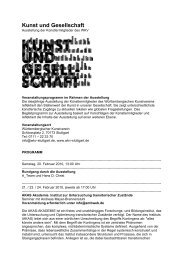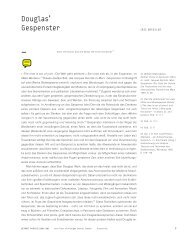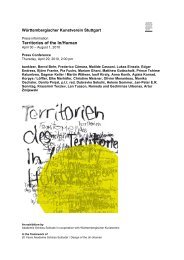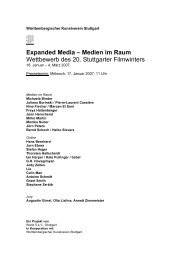English Texts
English Texts
English Texts
You also want an ePaper? Increase the reach of your titles
YUMPU automatically turns print PDFs into web optimized ePapers that Google loves.
to the work of prisoners who were working out their<br />
sentences, always, of course, under the strict supervision<br />
of the prisoner warders. The correspondents were<br />
prisoners who took on the task of collecting the news<br />
worth writing about at each penal centre, which<br />
made them eligible for an “extraordinary redemption”<br />
later. Thus, censorship and propaganda came from<br />
the heart of the Franco penal system, and the prisoners<br />
were subtly forced to be accomplices in it.’<br />
We know that Uberto M.B. worked on Redención.<br />
And that when they were released from gaol, the two<br />
cousins decided not to return to their home town, Lebrija,<br />
in the province of Seville. It was natural that the stigmas<br />
of a Marxist past and their time in prison should lead<br />
them to go first to Barcelona and in the late seventies<br />
to end their days in Badia del Vallès. The testimonies<br />
we collected about them tell us little about their activity<br />
on the Republican side and still less about their years<br />
in prison. Their behaviour is usual in many of those<br />
ex-convicts who took the road of rootlessness by hiding<br />
a supposedly ominous past for ever. The traces they<br />
have left in the different archives consulted leave no<br />
more than these few facts either. The two also worked<br />
in the prison archive and were in charge of the technical<br />
publication of ’s book, Musa redimida, Madrid 1940,<br />
an anthology of poems by prisoners under the working<br />
out sentences system we have already mentioned.<br />
Of Uberto M.B.’s contributions to Redención we can<br />
only single out his thematic unit devoted to praising<br />
the cooperation of the women’s prisons service on<br />
the reeducation of prisoners and its influence on the<br />
Women’s Section and the Falange. Of particular interest<br />
for an X-ray of the system is one which sets out the<br />
parallels between the illumination by the Jesuit Pérez<br />
del Pulgar of Señora Romana Roldán de Polanco,<br />
president of Frentes y Hospitales and representative<br />
of the Falange Española de las Jons, and the illumination<br />
by the Benedictine Fray Justo Pérez de Urbel – this<br />
character published a brief tome on the work of the<br />
iconoclastic hordes, Los mártires de la iglesia, which<br />
was in fact written by the journalist now known as<br />
Cándido – of Señora Pilar Primo de Rivera, president<br />
of the Women’s Section and also a member of the<br />
Falange Española de las Jons. Both ladies visited<br />
the prison and its workshops and were presented with<br />
a crucifix each from the ones manufactured by the<br />
convicts in their re-education programme.<br />
That is all we have been able to find from trawling<br />
archives, magazine collections and libraries. The people<br />
who knew them during the years they worked in<br />
Barcelona all insist on their refusal to talk about the<br />
past beyond a few vague references. That faded past<br />
on which the different groups engaged in reconstructing<br />
our historical memory are trying to shed light is not a<br />
product of chance either. The violence of this reeducation<br />
system was programmed precisely to wipe<br />
out any trace of any history that did not fit that of the<br />
winning side. The survivors who had been involved in<br />
iconoclastic actions – many of them were shot, even<br />
though they had committed no violent crimes, simply<br />
for having dressed up as priests, mocked the local<br />
patron saint or smacked the head of a cardboard altar<br />
boy placed at the door of the church to beg for alms –<br />
were specially re-educated through the application<br />
of the de-Marxisation campaign dreamt up by the<br />
famous psychiatrist Antonio Vallejo-Nájera. In his<br />
book Los campos de concentración franquistas<br />
Javier Rodrigo describes it in these words: ‘A good<br />
proof of the intention to re-educate dissidence and<br />
its practical implementation are the investigations,<br />
recently brought to light, by Doctor Vallejo-Nájera into<br />
the biopsychism of Marxist fanaticism and the purity<br />
of the “Hispanic race” in the international prisoners<br />
in San Pedro de Cardeña. With psychiatry at the<br />
service of ideology and with a series of psychological<br />
and, we fear, physical studies, his conclusions were<br />
nevertheless fairly predictable: Marxists were potentially<br />
mad or congenitally retarded, mentally feeble and<br />
therefore the eugenics required to revive the feeling<br />
of Spanishness consisted of locking up and separating<br />
the imbeciles. The difference is that the “race” in this<br />
case was of an ideological nature. As Carl Geiser<br />
points out in his memoirs, an assistant measured<br />
their skulls, the length of their noses and the distance<br />
between their eyes to “scientifically” classify them<br />
and demonstrate the mental, but also physical, natures<br />
of the madness brought about by leftwing thought.<br />
Ricard Vinyes has interpreted those examinations<br />
and analyses of the prison population from an<br />
audacious, brilliant perspective: how the Franco<br />
world structured through a “pseudo-philosophy of the<br />
social degeneration of the dissident” a global vision<br />
of the enemy and therefore of its own political being,<br />
based on Manichean precepts such as the opposition<br />
between superior and inferior, truth and error, Good<br />
and Evil.” In Cautivos, Javier Rodrigo’s book on the<br />
same subject, he writes: “Re-education was, in fact,<br />
another transversal element of the concentration<br />
camps, about which we can give two examples that<br />
liken the Franco camps to the ones usually considered<br />
totalitarian. The brainwashing of the Polish prisoners<br />
of war (the 250,000 or so captured on the Eastern Front<br />
after the Russian invasion that began on 17 September<br />
1939) in the Soviet camps of Kozelsk, Ostashkov and<br />
Atarobelsk is comparable to what had been done<br />
just one year earlier in San Pedro de Cardeña with the<br />
International Brigade prisoners. Not in the methods,<br />
infinitely more brutal in the Soviet camps – which aspired<br />
to the totalitarian creation of a new man – but in the<br />
background of a culturisation and sacralisationdogmatisation<br />
of politics, according to which ideology<br />
can be changed through conversion. The interest of<br />
Hitler and Himmler in using Russian prisoners of war<br />
in their own army from 1944, as well as Stalin’s contempt<br />
for them, are also comparable to Franco’s attitude<br />
towards his prisoners of war: either they were “deluded”<br />
and had to be “Hispanicised” to make them useful<br />
to the national community, or they were cheap,<br />
profitable labour, or simple “red scum” worth less<br />
than the bullet that would put an end to them.’<br />
And it is at this point that we have to go back,<br />
turn the discourse of this story in another sphere and<br />
place, the one corresponding to the Ute Meta Bauer<br />
entry in F.X. Archive It is obvious that the intersection<br />
comes from interest in the archive, the mechanisms of<br />
constructing it, its politics. Bauer’s work asks about<br />
the mechanisms of representation of the archive itself.<br />
In one of her latest works as curator, in (Insight) Archivo<br />
<strong>English</strong> <strong>Texts</strong> 759










